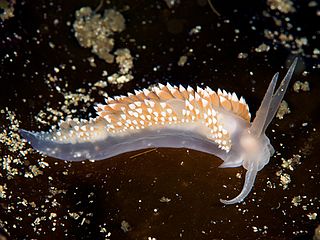
Graneledone is a genus of octopuses in the family Octopodidae.

Callitris verrucosa is a species of conifer in the family Cupressaceae. It is found only in Australia.
Kaloula verrucosa, the verrucous digging frog or Chinese narrowmouth toad, is a species of frog in the family Microhylidae. It is only known from the Yunnan–Guizhou Plateau of southwestern China in Sichuan, Yunnan, and Guizhou provinces, but it is expected to occur in adjacent Myanmar, Laos, and Vietnam. It is a very common species that lives in cultivated fields and in villages. Breeding takes place in temporary pools, ponds, and ditches.

Eunicella verrucosa, the broad sea fan, pink sea fan or warty gorgonian, is a species of colonial Gorgonian "soft coral" in the family Gorgoniidae. It is native to the north-eastern Atlantic Ocean and the western Mediterranean Sea.

Philotheca verrucosa, commonly known as Bendigo waxflower or fairy waxflower, is a shrub in the family Rutaceae. The species is endemic to south-east Australia. It is usually up to 1.2 metres high, although heights up to 2 metres have been recorded in Gippsland. It produces white flowers from August to October in its native range.

Eriphia verrucosa, sometimes called the warty crab or yellow crab, is a species of crab found in the Black Sea, Mediterranean Sea and eastern Atlantic Ocean from Brittany to Mauritania and the Azores. Individual crabs have been caught as far north as Cornwall. Formerly a frequent species in the Black Sea, it has decreased in numbers since the 1980s and is now listed in the Ukrainian Red Data Book of endangered species.

Brassia verrucosa, also known as warty brassia, is a species of plant in the family Orchidaceae native to Mexico, Central America, Venezuela, and Brazil.

Doris verrucosa is a species of sea slug, a dorid nudibranch, a marine gastropod mollusk in the family Dorididae.
Cymatiella columnaria is a species of predatory sea snail in the family Cymatiidae.
Cymatiella eburnea is a species of predatory sea snail in the family Cymatiidae.
Cymatiella pumilio is a species of predatory sea snail in the family Cymatiidae.
Cymatiella sexcostata is a species of predatory sea snail in the family Cymatiidae.

Hakea verrucosa is a shrub species in the family Proteaceae that is endemic to south-west Western Australia. It has large white, deep pink or red pendulous flowers with stiff needle-shaped leaves.

Coryphella verrucosa, is a species of sea slug, an aeolid nudibranch, a marine gastropod mollusc in the family Flabellinidae. It is found on either side of the northern part of the Atlantic Ocean.
Ralfsia verrucosa is a species of crustose brown seaweed in the family Ralfsiaceae. It grows intertidally in temperate waters around the world. In South Africa it is part of a mutualistic relationship with a limpet.

Pocillopora verrucosa, commonly known as cauliflower coral, rasp coral, or knob-horned coral, is a species of stony coral in the family Pocilloporidae. It is native to tropical and subtropical parts of the Indian and Pacific Oceans.

Rafflesia verrucosa was first identified and characterized during a small mammal survey of Mt. Kampalili in eastern Mindanao in 2010. R. verrucosa is the tenth species of Rafflesia found in the Philippines. Rafflesia species have rare and unusual flowers known for their large size and pungent smell. Some plant enthusiasts like Frits W. Went have gone to extreme measures to see these plants in bloom. Went detailed his search for Rafflesia saying,
"I had heard, when I was in Java many years ago, that Rafflesia were to be found on an offshore island named Nusah Kembangan. This was in 1929, when it was a penal colony for major criminals. My driver on this occasion was a convicted murderer, and my guide was serving time for cannibalism."

Aulactinia verrucosa, the gem anemone, is a species of sea anemone in the family Actiniidae. It is found on rocky coasts in the northeastern Atlantic Ocean, North Sea and Mediterranean Sea.

Verrucosa is a genus of orb-weaver spiders first described by Henry McCook in 1888. It contains almost fifty described species, most of which live in South America. The only species in the United States is the arrowhead spider.

Phialophora verrucosa is a pathogenic, dematiaceous fungus that is a common cause of chromoblastomycosis. It has also been reported to cause subcutaneous phaeohyphomycosis and mycetoma in very rare cases. In the natural environment, it can be found in rotting wood, soil, wasp nests, and plant debris. P. verrucosa is sometimes referred to as Phialophora americana, a closely related environmental species which, along with P. verrucosa, is also categorized in the P. carrionii clade.













